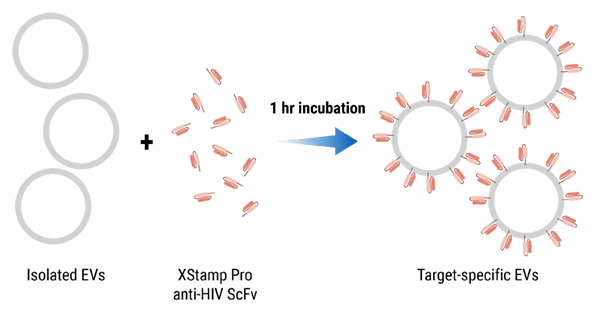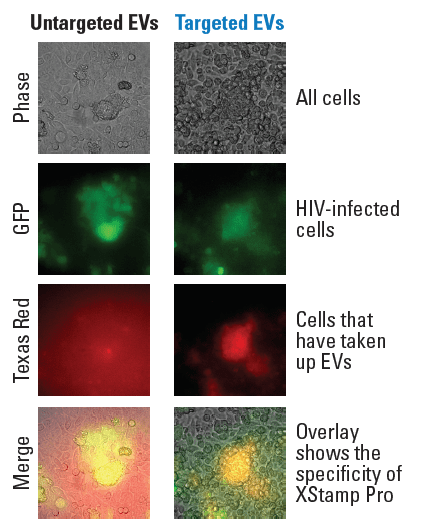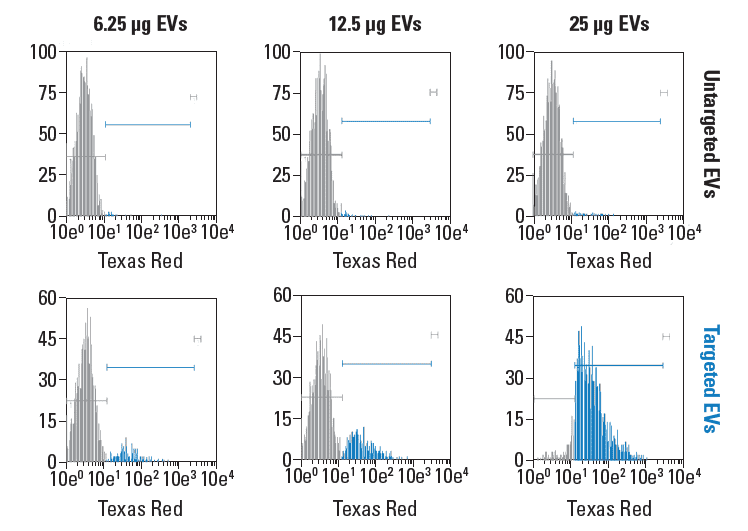XStamp™ Pro anti-HIV EV Targeting Kit
- Speed production of target-specific EVs with the next generation of XStamp technology
- Streamline engineering by working directly with purified EVs—no expression vector or transfection required
- Save hands-on time with a simple workflow—just incubate EVs with the XStamp ScFv for one hour and isolate target-specific EVs
- Easily generate multiple targeting variants for quick screening studies
- Compatible with any EV loading protocol
Products
| Catalog Number | Description | Size | Price | Quantity | Add to Cart | |||
|---|---|---|---|---|---|---|---|---|
| XSTP905A-1 | XStamp™ Pro anti-HIV EV Targeting Kit | 10 Reactions | $779 |
|
||||
Overview
Overview
Creating target-specific EVs just got a whole lot easier
The XStamp™ Pro anti-HIV EV Targeting Kit enables streamlined generation of extracellular vesicles (EVs) specific for HIV-infected cells. Just decorate the outside of already isolated EVs with the XStamp Pro anti-HIV ScFv and then isolated your target-specific EVs (see all of the targeting options in Table 1). Save time and simplify your EV engineering workflow with XStamp Pro.
While conventional methods for creating target-specific EVs are highly robust (see our XStamp Cloning and Expression Lentiector, Cat# XSTP710PA-1), they involve cloning and manipulation of the producer cells which can be challenging, especially if the cells are hard to transfect. To streamline this process and help researchers more quickly and easily create EVs that preferentially localize at a specific target, SBI turned to an exciting new technology, XStamp Pro, which works on already purified EVs—no cloning or transfection required. Simply incubate purified EVs with the XStamp Pro ScFv for one-hour and then isolate your target-specific EVs.
- Speed production of target-specific EVs with the next generation of XStamp technology
- Streamline engineering by working directly with purified EVs—no expression vector or transfection required
- Save hands-on time with a simple workflow—just incubate EVs with the XStamp ScFv for one hour and isolate target-specific EVs
- Easily generate multiple targeting variants for quick screening studies
- Compatible with any EV loading protocol
Each XStamp Pro anti-HIV EV Targeting Kit comes with enough XStamp Pro anti-HIV ScFv for 10 reactions* and ExoQuick-TC for EV isolation. Once the reaction is complete and your target-specific EVs are isolated, they are ready to use for cargo delivery.
For even faster workflows, you can use Exo-Fect siRNA/miRNA EV Transfection Reagent (Cat.# EXFT200A-1) or the original Exo-Fect Reagent (Cat.# EXFT10A-1 /20A-1) to load cargo into isolated EVs before adding the targeting specificity with XStamp Pro.
| Cat. # | Product | Specificity |
|---|---|---|
| XSTP900A-1 | XStamp Pro Streptavidin | Any - determined by user-supplied biotinylated moiety |
| XSTP905A-1 | XStamp Pro anti-HIV | HIV-infected cells |
| XSTP910A-1 | XStamp Pro anti-CD16 | CD16-expressing cells |
| XSTP915A-1 | XStamp Pro anti-PD-1 | PD-1-epxressing cells |
References
How It Works
How It Works
Engineer target specificity into already-purified EVs
XStamp Pro takes advantage of the same EV surface-directing protein used in our original XStamp products but skips the expression vector and the transfection step for a faster, simpler workflow. You get an already purified peptide consisting of the target-specific ScFv fused to the EV surface-directing protein—the XStamp Pro ScFv. Upon incubation with isolated EVs, the XStamp Pro ScFv self-inserts into EV membranes creating your target-specific EVs (Figure 1). Incubation is complete in 1 hour, after which the target-specific EVs can be isolated using the included ExoQuick-TC reagent or other isolation method of your choice, and then used to deliver cargo.
Figure 1. The streamlined XStamp Pro Streptavidin workflow.
Supporting Data
Supporting Data
See how effective XStamp Pro anti-HIV scFv is at delivering cargo

Figure 2. Target-specific EVs engineered using XStamp Pro are highly specific. We infected TZMbl cells with GFP-labeled HIV and exposed these cells to either non-targeting EVs (left column) or HIV-specific EVs coated with XStamp Pro anti-HIV ScFv and carrying a Texas Red-labeled siRNA (right column). Non-targeting EVs are not taken up by cells, and only HIV-infected cells internalize XStamp Pro anti-HIV EVs. Data courtesy of Rafal Kaminski and Kamel Khalili, Temple University.

Figure 3. Targeting EVs engineered using XStamp Pro are efficiently internalized. We treated GFP-labeled Jurkat 2D10 cells (a latent NL4-3-Dgag/pol-GFP lymphoid cell line) with 6.25, 12.5, or 25 μg of XStamp Pro anti-HIV EVs carrying Texas Red-labeled siRNA . After 24 hours we assessed EV internalization using flow cytometry. Uptake of targeting EVs is efficient and dose-dependent (bottom row, Texas Red-labeled cells are shown in blue). In contrast, non-targeting EVs are not internalized, further supporting the specificity of the XStamp Pro anti-HIV targeting. Data courtesy of Rafal Kaminski and Kamel Khalili, Temple University.
FAQs
Documentation
Citations
Related Products
Products
| Catalog Number | Description | Size | Price | Quantity | Add to Cart | |||
|---|---|---|---|---|---|---|---|---|
| XSTP905A-1 | XStamp™ Pro anti-HIV EV Targeting Kit | 10 Reactions | $779 |
|
||||
Overview
Overview
Creating target-specific EVs just got a whole lot easier
The XStamp™ Pro anti-HIV EV Targeting Kit enables streamlined generation of extracellular vesicles (EVs) specific for HIV-infected cells. Just decorate the outside of already isolated EVs with the XStamp Pro anti-HIV ScFv and then isolated your target-specific EVs (see all of the targeting options in Table 1). Save time and simplify your EV engineering workflow with XStamp Pro.
While conventional methods for creating target-specific EVs are highly robust (see our XStamp Cloning and Expression Lentiector, Cat# XSTP710PA-1), they involve cloning and manipulation of the producer cells which can be challenging, especially if the cells are hard to transfect. To streamline this process and help researchers more quickly and easily create EVs that preferentially localize at a specific target, SBI turned to an exciting new technology, XStamp Pro, which works on already purified EVs—no cloning or transfection required. Simply incubate purified EVs with the XStamp Pro ScFv for one-hour and then isolate your target-specific EVs.
- Speed production of target-specific EVs with the next generation of XStamp technology
- Streamline engineering by working directly with purified EVs—no expression vector or transfection required
- Save hands-on time with a simple workflow—just incubate EVs with the XStamp ScFv for one hour and isolate target-specific EVs
- Easily generate multiple targeting variants for quick screening studies
- Compatible with any EV loading protocol
Each XStamp Pro anti-HIV EV Targeting Kit comes with enough XStamp Pro anti-HIV ScFv for 10 reactions* and ExoQuick-TC for EV isolation. Once the reaction is complete and your target-specific EVs are isolated, they are ready to use for cargo delivery.
For even faster workflows, you can use Exo-Fect siRNA/miRNA EV Transfection Reagent (Cat.# EXFT200A-1) or the original Exo-Fect Reagent (Cat.# EXFT10A-1 /20A-1) to load cargo into isolated EVs before adding the targeting specificity with XStamp Pro.
| Cat. # | Product | Specificity |
|---|---|---|
| XSTP900A-1 | XStamp Pro Streptavidin | Any - determined by user-supplied biotinylated moiety |
| XSTP905A-1 | XStamp Pro anti-HIV | HIV-infected cells |
| XSTP910A-1 | XStamp Pro anti-CD16 | CD16-expressing cells |
| XSTP915A-1 | XStamp Pro anti-PD-1 | PD-1-epxressing cells |
References
How It Works
How It Works
Engineer target specificity into already-purified EVs
XStamp Pro takes advantage of the same EV surface-directing protein used in our original XStamp products but skips the expression vector and the transfection step for a faster, simpler workflow. You get an already purified peptide consisting of the target-specific ScFv fused to the EV surface-directing protein—the XStamp Pro ScFv. Upon incubation with isolated EVs, the XStamp Pro ScFv self-inserts into EV membranes creating your target-specific EVs (Figure 1). Incubation is complete in 1 hour, after which the target-specific EVs can be isolated using the included ExoQuick-TC reagent or other isolation method of your choice, and then used to deliver cargo.
Figure 1. The streamlined XStamp Pro Streptavidin workflow.
Supporting Data
Supporting Data
See how effective XStamp Pro anti-HIV scFv is at delivering cargo

Figure 2. Target-specific EVs engineered using XStamp Pro are highly specific. We infected TZMbl cells with GFP-labeled HIV and exposed these cells to either non-targeting EVs (left column) or HIV-specific EVs coated with XStamp Pro anti-HIV ScFv and carrying a Texas Red-labeled siRNA (right column). Non-targeting EVs are not taken up by cells, and only HIV-infected cells internalize XStamp Pro anti-HIV EVs. Data courtesy of Rafal Kaminski and Kamel Khalili, Temple University.

Figure 3. Targeting EVs engineered using XStamp Pro are efficiently internalized. We treated GFP-labeled Jurkat 2D10 cells (a latent NL4-3-Dgag/pol-GFP lymphoid cell line) with 6.25, 12.5, or 25 μg of XStamp Pro anti-HIV EVs carrying Texas Red-labeled siRNA . After 24 hours we assessed EV internalization using flow cytometry. Uptake of targeting EVs is efficient and dose-dependent (bottom row, Texas Red-labeled cells are shown in blue). In contrast, non-targeting EVs are not internalized, further supporting the specificity of the XStamp Pro anti-HIV targeting. Data courtesy of Rafal Kaminski and Kamel Khalili, Temple University.

